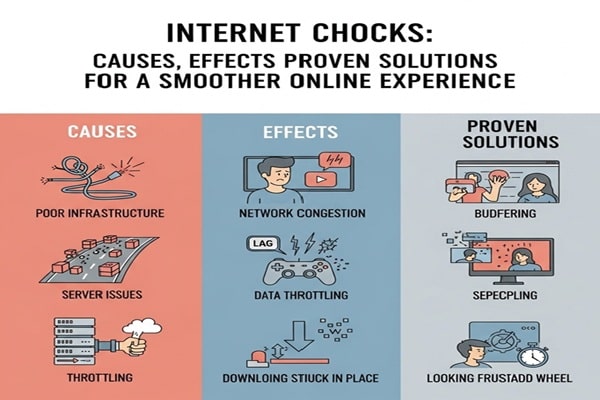
Newsletter Subscribe
Enter your email address below and subscribe to our newsletter

Enter your email address below and subscribe to our newsletter

Ever found yourself stuck in the middle of a Zoom call or a Netflix binge only to be greeted by buffering, lag, or that annoying spinning wheel? If yes, you’re not alone—and what you’re likely experiencing is something called an internet chock. These sudden slowdowns or disruptions in your internet can turn everyday online tasks into frustrating chores.
Let’s break down exactly what internet chocks are, what causes them, how they affect your digital life, and most importantly—how to fix them.
“Internet chock” might not be a term you hear every day, but chances are you’ve felt its effects. It refers to those irritating moments when your internet slows to a crawl or cuts out completely. Think laggy video calls, choppy gaming sessions, or payments failing mid-transaction. These chocks often strike without warning and can seriously disrupt your productivity—or your relaxation time.
Before you can fix the problem, you’ve got to understand what’s causing it. Here are some of the most frequent triggers behind unstable internet connections:
This one’s especially common during peak hours—think evenings or weekends. When too many devices in your home (or neighborhood) are online at the same time, your bandwidth gets stretched thin.
Thick walls, long distances, and interference from household items like microwaves can all weaken your Wi-Fi. The result? Dropped connections and slow speeds in certain parts of your home.
Still using that router from 2015? It might not be up to the task. Older modems and routers often can’t handle the demands of modern internet usage, especially in households with multiple users.
Some internet service providers intentionally slow down traffic for certain types of online activities like streaming or gaming, especially when you’ve hit a data cap. This is known as throttling, and it can really mess with your speed.
Your baby monitor, cordless phone, or even the microwave can mess with your signal. These devices operate on similar frequencies as your router, leading to signal interference.
Your router’s software, or firmware, might need an update. Bugs or outdated code can degrade performance and cause connection issues.
Heavy rain, strong winds, or storms can damage infrastructure, especially if you’re using cable or satellite internet. This can lead to temporary or ongoing service problems.
When your internet connection hiccups, it can disrupt almost everything you do online. Here’s how:
Nothing ruins movie night faster than constant buffering. Low-quality video and random pauses can make streaming a nightmare.
Gamers know the pain of high ping. Choppy gameplay and lag can make competitive games almost unplayable—and definitely no fun.
Video calls cutting out mid-meeting? File uploads stuck forever? Internet chocks can kill your productivity and cause you to miss key deadlines.
Trying to check out online or transfer money and your browser freezes? That’s not just annoying—it can cost you real money or cause major delays.
Apps like Zoom, Skype, and Google Meet require stable connections. Any chock can mean frozen screens, distorted audio, and dropped calls.
Also Read : Tecnoregio News: Your Premier Source for Technology and Innovation Updates
Now that we’ve covered the problems, let’s talk about the solutions. Here’s how you can improve your connection and avoid those irritating slowdowns:
If you’re streaming, gaming, working remotely, and have multiple users online, your current plan might not cut it. Look into a higher-speed plan with more bandwidth to meet your household’s needs.
Put your router in a central, elevated location away from walls and other electronics. Avoid tucking it in a cabinet or corner—it needs open space to spread that signal evenly.
Wi-Fi is convenient, but Ethernet cables offer more stable and faster speeds. For tasks that need reliability—like gaming or video calls—go wired.
Check your router’s settings and make sure it’s running the latest firmware. Manufacturers regularly release updates to improve performance and fix bugs.
Close apps running in the background that you’re not using—especially those that auto-update or sync data. These can quietly eat up bandwidth without you noticing.
If your router is more than a few years old, it might be time for a replacement. Look for routers with the latest Wi-Fi standard (Wi-Fi 6 or higher) and dual-band or tri-band support.
Keep your router away from electronic devices that might interfere with its signal—things like cordless phones, baby monitors, or even smart fridges.
If you live in a large home or have multiple floors, a mesh system can spread your Wi-Fi signal evenly across the space—no more dead zones.
Still struggling even after trying everything? Get in touch with your internet provider. There might be service issues in your area or better packages available.
Internet chocks are sudden disruptions or slowdowns in your internet connection. They can be caused by network congestion, interference, outdated hardware, or ISP limitations.
If your connection is mostly fine but suddenly slows down during peak hours or when many devices are online, chances are you’re dealing with a chock.
Sometimes. VPNs can help bypass ISP throttling, but they can also slightly slow your connection. If throttling is the issue, a VPN may help.
Look for a router that supports Wi-Fi 6 (802.11ax), has dual or tri-band capability, and offers features like QoS (Quality of Service) for traffic prioritization.
Yes. Mobile data can experience congestion, especially in crowded areas or during events. Try switching to Wi-Fi or using mobile data during off-peak times.
In today’s fast-moving, always-connected world, internet chocks are more than just a minor annoyance—they can impact your productivity, entertainment, and peace of mind. But with a little knowledge and a few smart upgrades, you can take control of your connection.